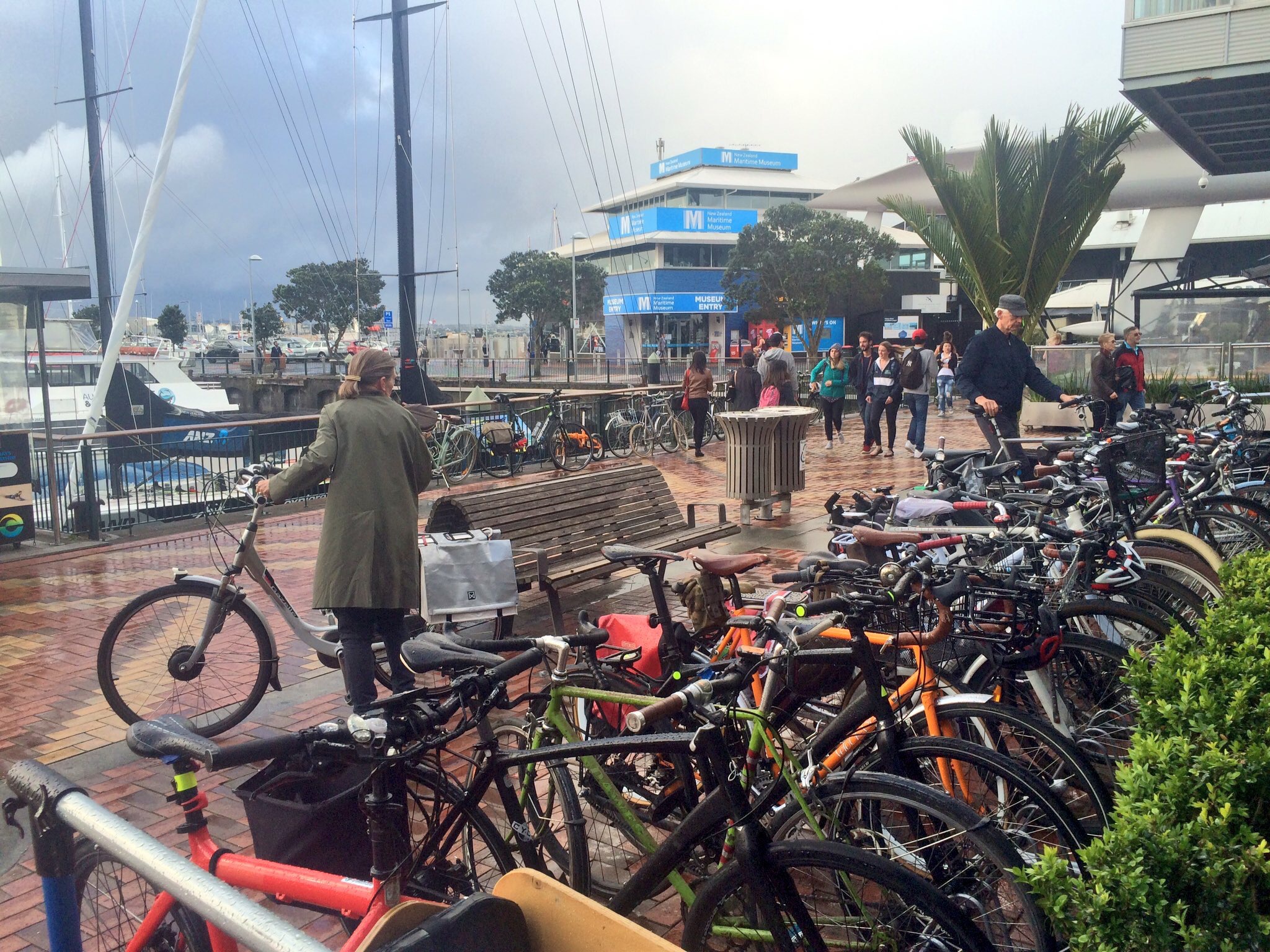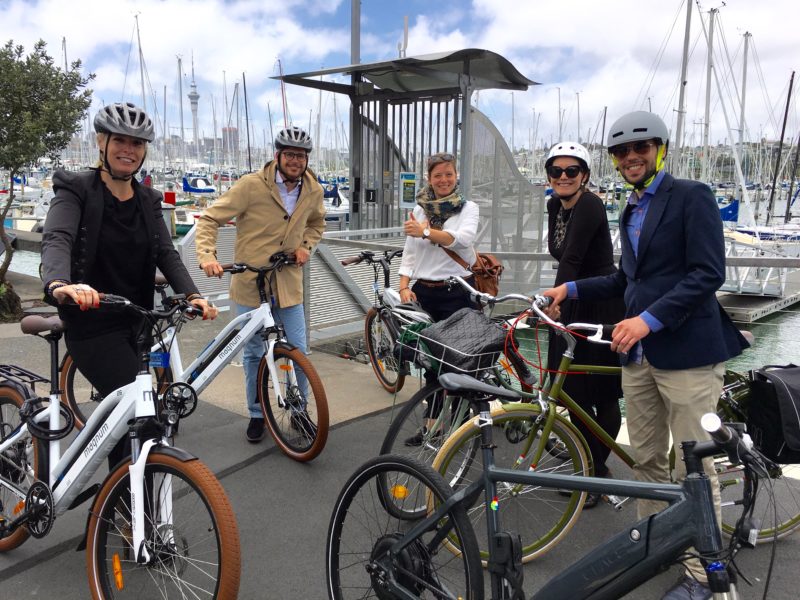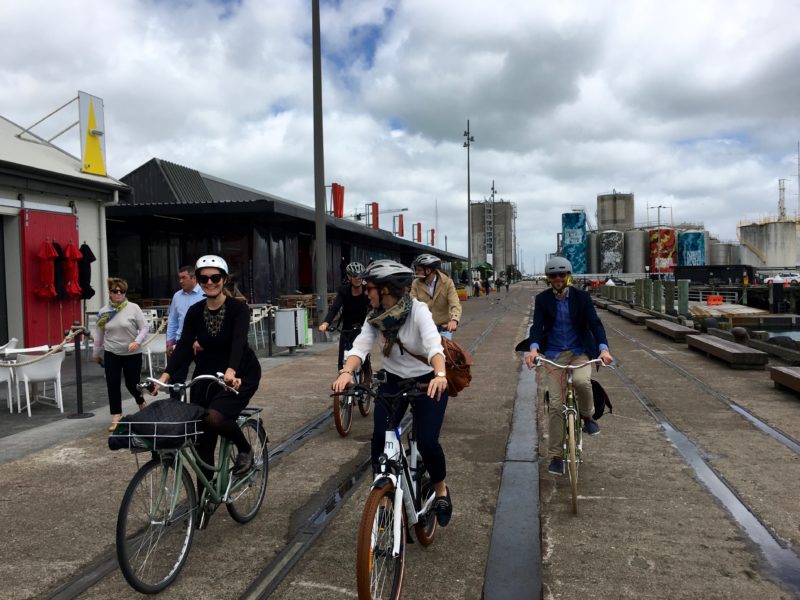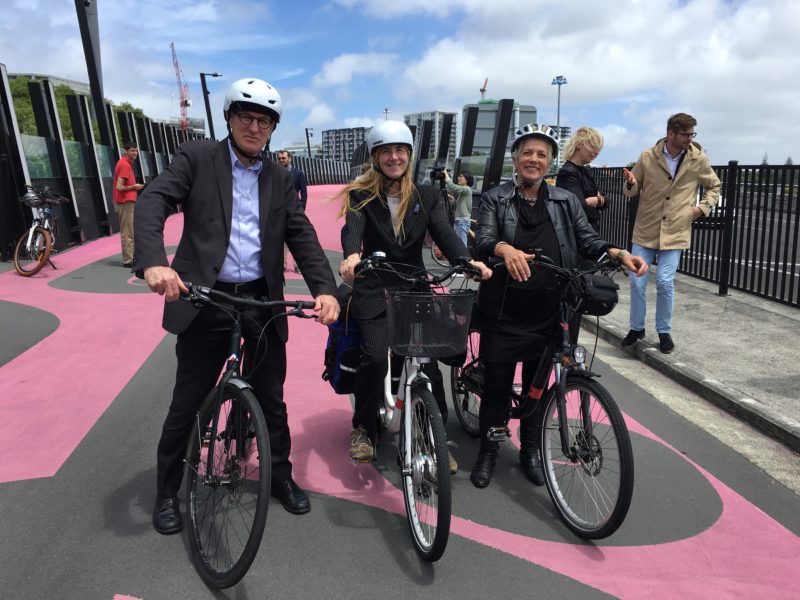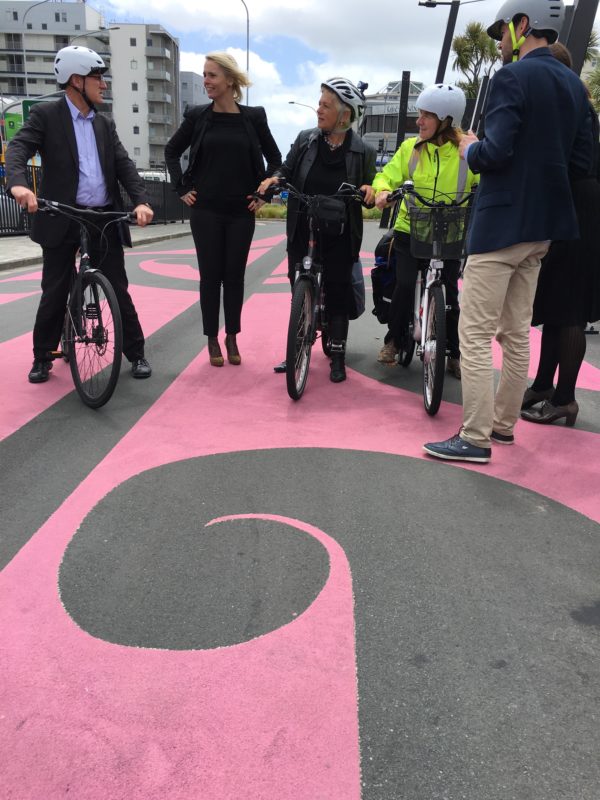(Sorry for the groanworthy pun, just trying to avoid another of those ‘going Dutch’ headlines…) On a rainy Monday night in Auckland, a standing room only crowd gathered eagerly to hear from the visiting Dutch Cycling Embassy. Most had arrived on bikes – including beautiful Dutch bikes, which formed a striking panorama on the Viaduct, outside The Original.
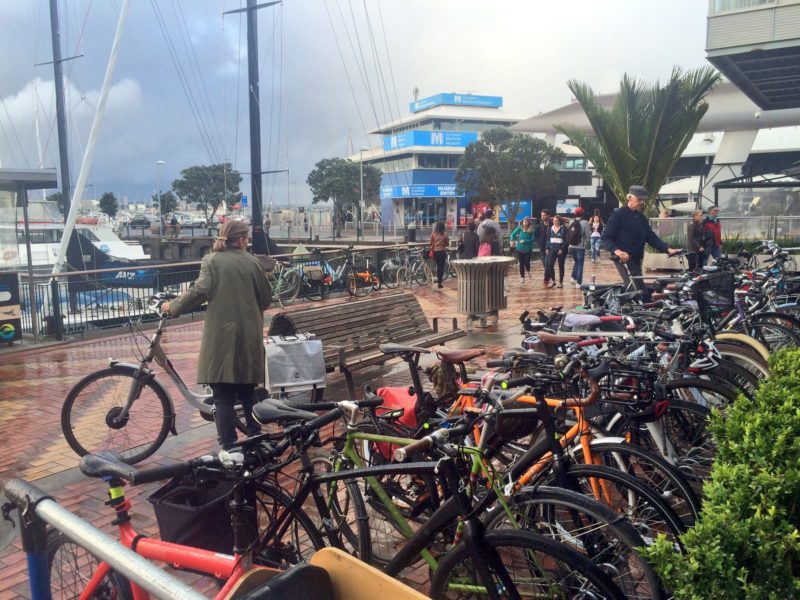
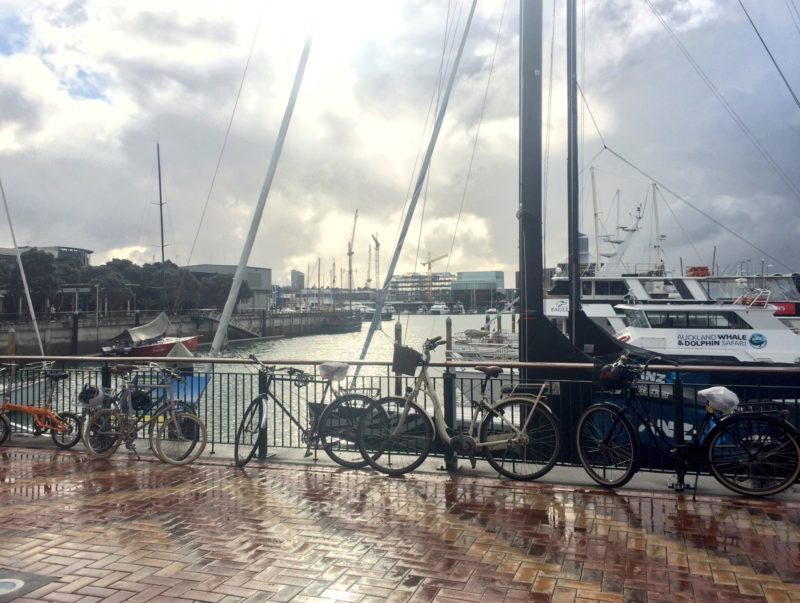
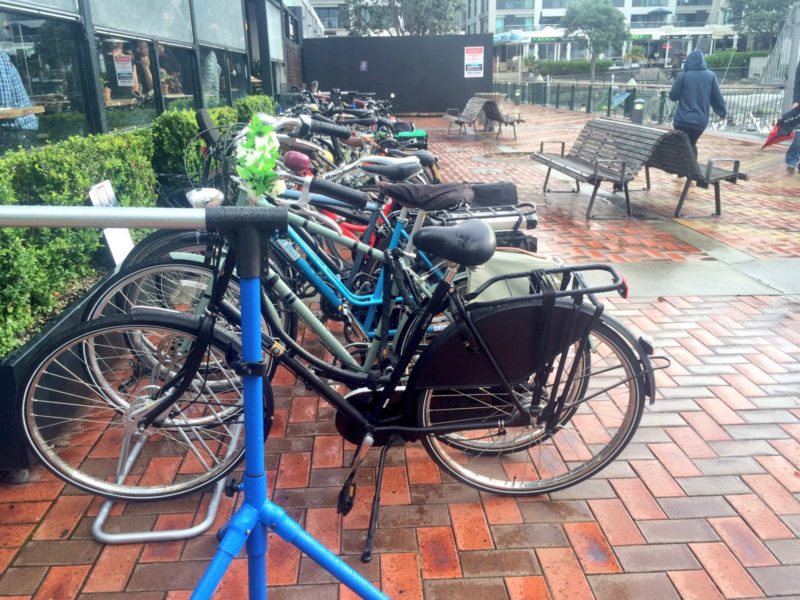
Huge thanks go to the venue for hosting us at short notice; to the good people at Auckland Transport for running the event, live-streaming it (video available here) and providing valet parking; and to MR Cagney for support.
A stirring speech of welcome was delivered by Councillor Chris Darby, one of our bike-friendliest city leaders, expressing just how hungry Aucklanders are for better ways to get around. In a nice touch, Chris acknowledged Bevan Woodward (standing modestly to one side of the room) whose tenacious vision for SkyPath moves closer every day. The crowd was extremely happy to oblige with a round of applause.
Then it was over to Mirjam Borsboom, the engaging and very knowledgeable director of the Cycling Embassy. She first asked for a show of hands. How many Dutch people in the room? Quite a few. How many people had been to the Netherlands? More hands went up; an impressive number. How many had cycled while there? All the hands stayed up. How many had loved it? A forest of waving hands.
Assisted by colleague Edward Douma, Mirjam gave an overview of the work of the Embassy, a small non-profit that travels the world sharing Dutch intelligence about how to transform any city into a cycling city. A quick precis of the Dutch cycling revolution was then followed by some first-impression snapshots of Auckland’s infrastructure for discussion.
Due to scheduling logistics, the talk was happening before the visitors had a chance to see our more recent (and increasingly gold-standard) bits of bikeway. But in a way, this was useful: as we know only too well, Auckland is really big. We’re playing catch-up after decades of civic neglect, and not every part of town gets to enjoy protected lanes or a pink path.
So it’s important to confront our flaws and challenges and our often disconnected scraps of infrastructure. And there they were, seen through the eyes of a visitor.
Advance stop boxes. Paint-only bike lanes (“Well, at least it’s green,” said Mirjam, kindly). Sweeping curves that give vehicles the royal treatment and pedestrians nowhere to hide. Ridiculously wide roads with ridiculously wide lanes, impossible to cross on foot before the light changes. Skimpy footpaths.
As the images flashed up on the screen, it was hard not to cringe a bit. But Mirjam, like a personal trainer or a kind teacher, encouraged the crowd to always find something to value, something to work with. “Tell me how you feel about these,” she prompted. After a few comments about how embarrassingly far behind we were, someone called out “I love that green bike box! I can say to the drivers, it’s for me!” “True, it’s an acknowledgement,” chimed in another person. “At least it shows bikes are allowed to be there.”
Once the self-consciousness lifted, more challenging comments and eager questions poured forth.
What does the Cycling Embassy think of half-way measures, fixes that are far from perfect but better than nothing? Are they place-holders for a better future, or a waste of time? “See the good in what you have… but aim for the stars,” was the cycling ambassador’s diplomatic reply.
(“Yes, but why not do it right first? Why build things twice?” came the word from elsewhere in the room, to murmurs of agreement all round.)
There was a question about the way the 1970s oil crisis sparked a change in Dutch driving habits – could the “obesity crisis” be New Zealand’s equivalent? (And some righteous debate: can this be done without vilifying obese people?) Of course there are compelling public health benefits in making active travel safer and more attractive for everyone… but when it comes to behaviour change on the national scale, are future health benefits as convincing to the average person as an existing gas shortage that hits you in the wallet?
Another question: what if the NZ government bought everyone a bike? Well, firstly, they’d solve the problem of bike theft overnight… (This point was hard to argue with!)
How can we encourage children to bike to school, when it doesn’t feel safe? Mirjam observed that in the Netherlands, school zones are “super obvious” – you always know when you’re near a school; there’s signage, much slower speeds – and of course lots of kids on bikes. There was nice discussion of the mutual confidence of parents and children when bike infrastructure is built for all ages; and the rite of passage of becoming an independent child on a bike. “Children love independence and freedom.”
Mirjam acknowledged the challenge of spending a small budget. “It’ll never be easy. But stay positive, that at least there is a budget! Spend it wisely. Where to start first? Maybe with schools?” (Hello, Mayor Goff!).
There were questions about bike parking solutions, about shared paths, about intersections – “They’re the hardest part. But you can build examples, then cut and paste and improve as you extend the cycle infrastructure. Don’t take the easy way out.”
Mirjam also pointed out that you don’t need a bike lane on every street. You can create critical mass by clustering bike travel along key routes. “Think of a structure, and make a strategy with that vision,” she said, citing Calgary’s minimum grid as an example.
Helmet law came up, of course. “In Holland, we’re not a big fan of the helmet,” was the gentle response. “The intermediate phase [between building good infrastructure and making helmets non-compulsory] is the hard one.” Mirjam noted she’d lived in Australia and felt better riding with a helmet there, and she always wears a helmet when out on her road bike in the Netherlands. But, she urged, “in the city you need to provide infrastructure where people don’t need a helmet. You should design for helmetless biking.”
Barb Cuthbert observed that with Auckland in major catch-up mode, the central city is the current focus, while the rest of the city mostly stands waiting. What, she asked, can be done in the meantime to make those ‘burbs more bikeable, especially for local trips and biking to school? “We can’t magic Auckland into cycling Nirvana overnight,” said Barb, “but people in those neighbourhoods deserve better.” Lower speed zones are obviously key, but there doesn’t seem to be a great sense of urgency about this at national or local government level; likewise for law changes to give pedestrians and people in cycleways right of way across side streets.
Mirjam’s response was sympathetic: she noted that persuasive campaigns persuading drivers to be more attentive to people on bikes was part of the picture, alongside law changes. And she noted again how very wide Auckland’s streets are, and suggested visually narrowing them to encourage drivers to slow down. She also encouraged local input: residents working with maps of the area to plot origins, destinations, and flows, so as to plan infra priorities for when the budget shows up. (In effect, this is exactly what Bike Devonport and Bike Te Atatu and other energetic bike burbs are doing… our enthusiasm and local expertise is solid; it’s just awaiting budget and capacity.)
As the evening ended, with a sense of barely tapped passion – oh, the great smoldering volcano of Auckland’s growing bike culture! – Mirjam summed up the way forward:
“Start somewhere. Be happy with the change. Thank the people who are designing it. And keep going!”
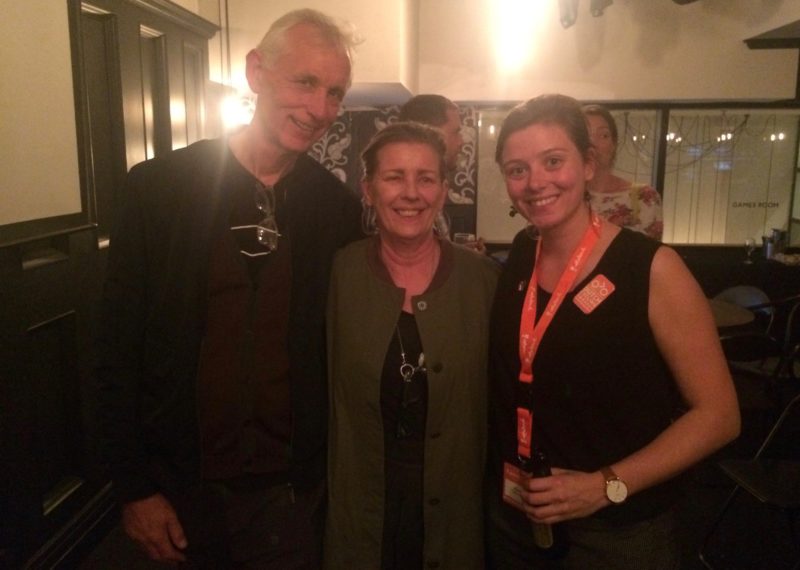
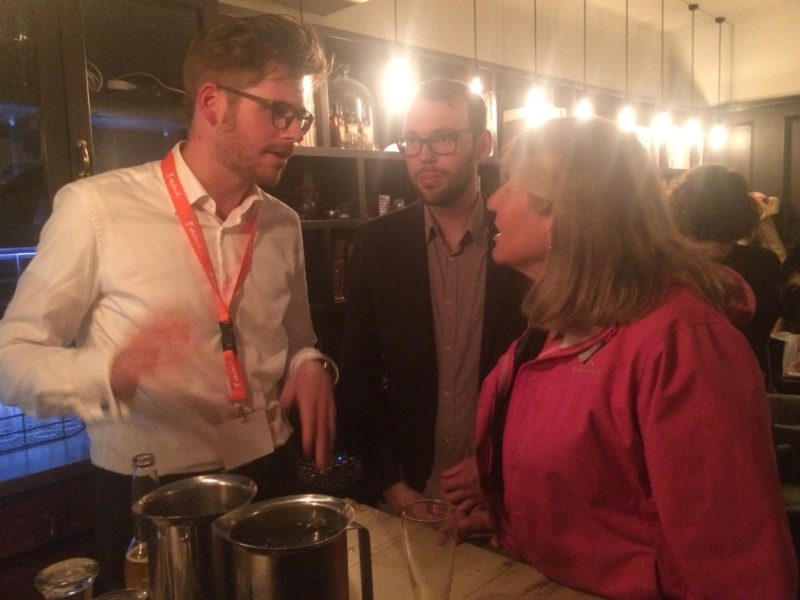
The following day, blustery but blue-sky, our Dutch visitors finally got to experience the best of what Auckland’s built so far. In between meetings and workshops, they were equipped with e-bikes and taken on a tiki tour around the central city’s showpiece cycleways, including of course Quay St, the Westhaven Promenade, and Lightpath.
The visitors were accompanied by a bevy of bike-friendly civic leaders and advocates: Kathryn King, AT’s walking and cycling manager; Bike Auckland’s Bruce Copeland; John Mauro, Council’s Chief Sustainability Officer – and some of our most bike-friendly councillors, including Chris Darby, Penny Hulse, and Cathy Casey, who were eager to swap ideas about a more bikeable Auckland.
Of course, Lightpath/ Te Ara i Whiti got a huge tick from the Cycling Ambassadors. As Mirjam says in that article: “It’s very impressive infrastructure. I think every city needs an iconic cycling path… but this is really exceeding expectations.” And what could make it even better? “I think filling out these missing gaps or links to get a complete network structure is a really good strategy to go.”
And it’s excellent to hear this, from Kathryn King: “It’s really great to have experts from the nation that does cycling the best, here to give us tips and pointers. For us that’s been an amazing opportunity to upskill and get some really good ideas from them that we can start to employ here,”
Right then. The way ahead is clear. We’ve started somewhere – let’s keep going!

